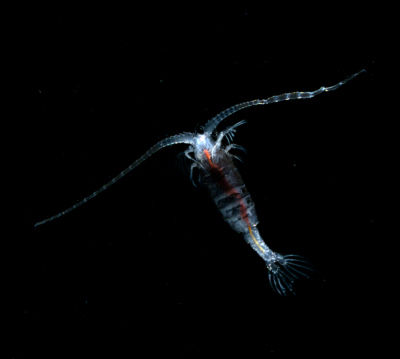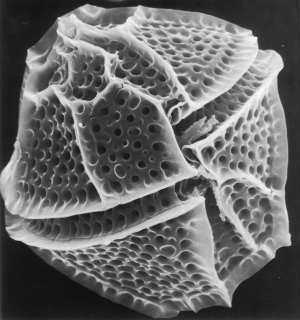Bioluminescence in Dinoflagellates
Biology 342 Fall 2010
Caitlin Miller and Madeline Dansky
Adaptive Value
Adaptive value is an explanation of an organisms characteristics in terms of how it provides a selective advantage (18)
Why Luminate?
There are a couple of different reasons why organisms luminate using bioluminescence. These can include predator evasion, attracting prey, and to communicate or advertise within their species. It has been suggested that dinoflagellates luminate as a defense mechanism against their predators, the copepods, which are small crustaceans and nocturnal feeders (22).
Organism in the image (left) is a cocepod, Gaussia princeps. This species of cocepod is bioluminescent, produces light from secretions in tail glands (14).

image courtesy: Edith A. Widder Harbor Branch Oceanographic Institution (14).
Potential Advantages of Light Emission
Research has shown that dinoflagellates bioluminesce during small changes in pressure, which would occur if a copepod were present in their environment. Since the copepods feed at night, the dinoflagellates emit light so that the copepods can be seen and thus eaten by their own predators. This reduces the amount of copepods able to feed upon the dinoflagellates. This relationship has been studied by looking at the swimming speed of copepods in the presence of dinoflagellate bioluminescence. It has been shown that there is a very strong increase in swimming speed when blue light in present (22). Copepod feeding behavior mainly takes place when the organism is stationary (27). This increase in swimming speed makes it more difficult for copepods to be preyed upon, but also makes it more difficult for them to feed upon dinoflagellates. When non-luminous dinoflagellate species were created in the laboratory, they were fed upon by copepods at significantly higher rates than the natural luminescent species, showing that the bioluminescence has a negative effect on copepod grazing.

Right Image. Lingulodinium polyedrum (also known by pervious name Gonyaulax polyedra)
image courtesy: Coturnix, 2006 (20)
Dinoflagellates Only Luminate at Night
In terms of adaptive value, it is reasonable that the production of light would function on a circadian clock. The emission of light is requires energy, and in the daylight the light is not visible and so the intended “signal” being produced is not able to be received. Furthermore, the light production coincides with predator feeding patterns.
A Toxic Warning Sign
It has been suggested that the bioluminescence could be used as a warning sign from dinoflagellates that produce toxins, since copepods can outswim dinoflagellates. In nontoxic species it acts as a warning sign that would deter copepods that don’t wish to be seen by their carnivorous predators (27). It is also suggested that the nontoxic species are using mimicry to deter prey, whose predators which might assume that they also contain toxins (21). Dinoflagellates' bioluminescent behavior impacts the behaviors of other organisms in their environment, using light emission to suit their own needs.